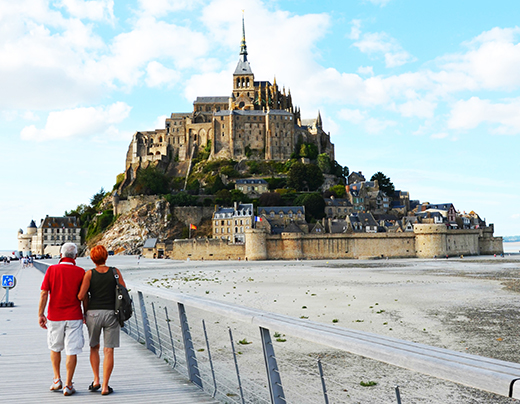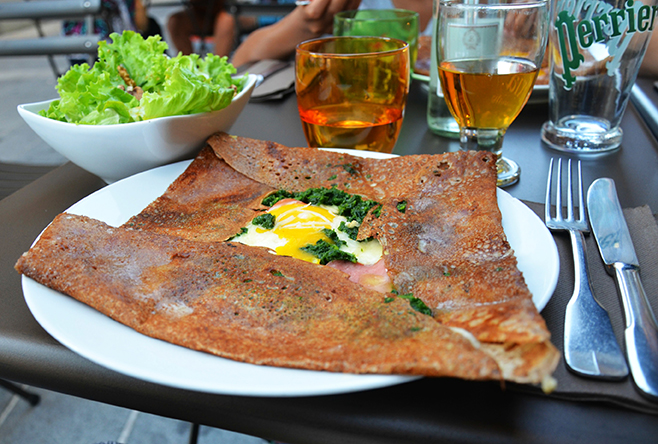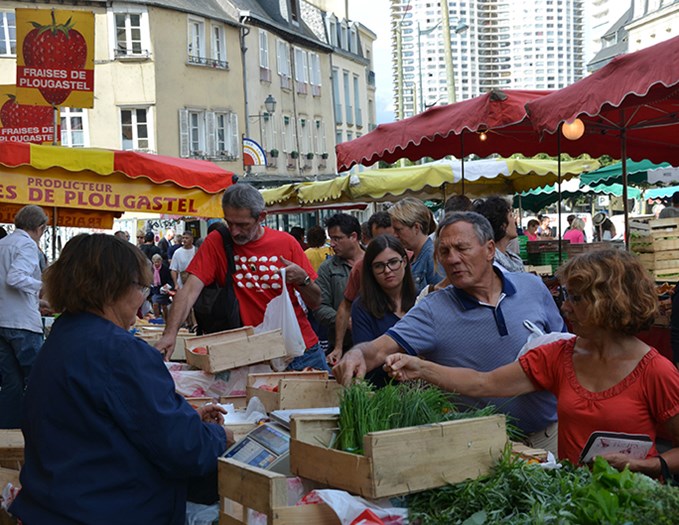SAINT-MALO, FRANCE - Standing on the stonewall of this old town, the salty sea breezes are gentle and the warm sunshine highlights the sea’s multiple shades of blue as the surf comes ashore on the beach below. Centuries before, explorer Jacques Cartier probably stood close to where I’m standing gazing out to sea, wondering what he would discover for King Francis I when he set out for the New World.
In present-day Saint-Malo, a statue of Cartier overlooks the sea from the ramparts, a swirl of visitors constantly taking photos of the man who proclaimed the territory discovered on the other side of the Atlantic as New France, which would eventually become Canada.
Saint-Malo’s old town of cobblestone streets, restaurant terraces and gift shops are just as bustling as the past, now with tourists instead of traders. Ships now ferry travellers along the coast or to the nearby Channel Islands, as opposed to the sea-trading routes to the Mediterranean, North Africa and beyond.


Left: Tourists marvel at Mont Saint Michel. Right: The Mechanical Elephant draws a crowd.
At the beginning of the 1600s, 6,000 French immigrated to the colony of New France, soon inhabiting the areas of the present-day Canadian Maritimes and Quebec. Their descendants and many others now travel to Brittany, lured here to discover the region that gave birth to their ancestors.
Travellers may initially want to visit Brittany because of its famous historic and religious site, Le Mont Saint-Michel, the second most-visited attraction in France after Paris. But this west coast region offers walkable cities with contemporary culture and memorable wine and cuisine.
Cities like Nantes, the former seat of the Duché de Bretagne from 949 to 1537. Nantes was an economic centre in western France thanks to its location along Loire River up from the sea. Now it’s a city renewed in recent years by modern art and a growing population of newly-transplanted Parisians wanting to escape big city detriments.
The recently restored Château des ducs de Bretagne reveals the history of Nantes through its buildings and exhibits, as does walking the streets and enjoying the distinctive 19th-century style of the city’s L’île Feydeau, paired with new additions such as the Jardins des Fonderies — a contemporary botanical garden opened in 2009 — and the Le Mémorial de l'abolition de l'esclavage, a museum illuminating the city’s role in the slave trade.
Thanks to the ingenuity of two modern artists/inventors, the derelict left bank of the Loire River has been renewed. In 2007, Francois Delaroziere and Pierre Orefice transformed the former shipyards into Les Machines l'île, an industrial-meets-futuristic interactive art gallery inspired by the imaginations of Nantes novelist Jules Verne and Leonardo da Vinci. The fantastical modern-day machines include The Great Elephant, The Marine Worlds Carousel and The Heron Tree, each one a seemingly far-fetched, yet real, carnival ride celebrating the worlds of nature and technology.
Le Voyage à Nantes, the annual summer arts festival, has also made the riverfront and other neighbourhoods placed for creativity to blossom.


Left: Enjoying the local treat, galette. Right: The area's markets are always a beehive of activity.
Located in the heart of Nantes, La Cigale celebrates traditional Breton cuisine. Originally opened in 1895, a meal at this Art Nouveau brasserie should start with a glass of crisp Muscadet, the white wine varietal of the region, a baguette with Breton butter (which always includes sea salt) and a plat du jour inspired by classic French cuisine (such as confit du canard), or the abundant seafood, such as la lotte (monkfish), oysters from Cancale, or the distinctive Breton lobster with its blue shell. And for a sweet treat, go around the corner to Georges Gautier for tempting sea salt caramels, chocolates and popular hard candies, berlingots de mantes, or pop into a patisserie for le gâteau nantais, a traditional almond cake made with rum.
In an hour and a half by train, visitors can arrive in Rennes from Nantes, known for its medieval wood homes, music festivals and as one of the favourite cities of foreigners who decide to move to France. The city’s numerous bike paths and compact size also make Rennes welcome for visitors, who can easily navigate from the 14th-century Mordelles Gates to the Brittany Parliament, along the pathways of the Vilaine River to the bustling evening music venues such as L'Étage or La Cité.
Since the 1980s, when Rennes was crowned the new wave music capital of France, the city has been host to a multitude of music and arts festivals, including Les Tombées de la Nuit, which showcases cutting-edge performance and visual arts. The music tradition has carried over to Le Magic Hall, an eclectic boutique hotel found within a residential neighbourhood.
One of the city’s most popular weekly events is the Marché des Lices — the second largest open-air market in France, which is held every Saturday morning, bringing together the best of the region — seasonal flowers, fruit, vegetables, meat and seafood as well as baked goods, dairy products, preserves and sea salt. A galette saucisse (a grilled sausage wrapped in a crepe) is the street food snack to help survive the crowds and help prevent a grumbling stomach.
Two hours along France’s northwest coast from Rennes lies the historic site of Le Mont Saint-Michel. Located on a rocky island in the estuary of the Couesnon River, this island village and abbey situated on the border of Brittany and Normandy. Located on the traditional pilgrims’ route since medieval times, this sanctuary was built by the Benedictines on an isle, routinely cut off from the mainland with the changing tides.
Now, the devout and the curious make the trip to the island, walking or taking the shuttle the two kilometres to the bridge that connects the mainland to the first steps leading into the village, home to fewer than 50 people. Over 900 steps up lead to the doors of the abbey, the cathedral and cloisters. There are hidden chapels, unbeatable views of the surrounding areas, as well as places for solace and reflection within the sacred walls overlooking the vast estuary and surrounding sands and land.
The sea is the raison d'être of this region – from its seafaring history and connection to distant lands to its cuisine and cities, visitors to Brittany will understand this coastal region’s welcoming allure.
Information
Canadians can access Brittany through seasonal flights on Air Canada and Air Transat and explore between the cities of Nantes, Rennes and Saint-Malo via train on Rail Europe. / Before visiting, check out these websites:
www.nantes-tourisme.com/en &
www.tourisme-rennes.com/en